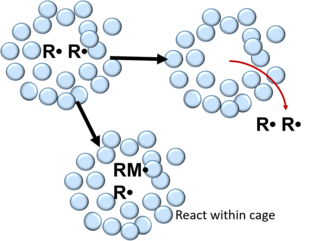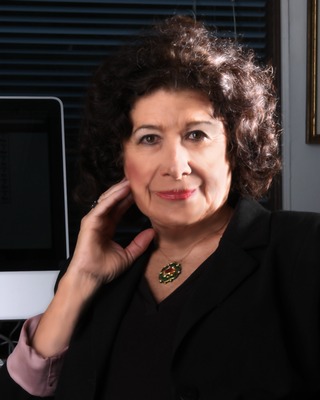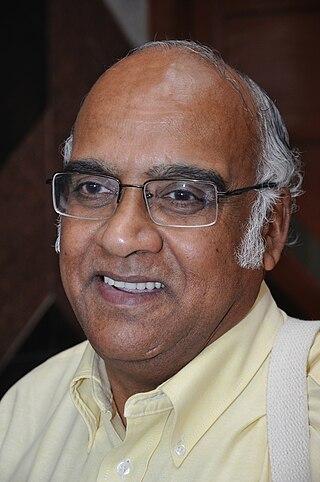
The International Union of Pure and Applied Chemistry is an international federation of National Adhering Organizations working for the advancement of the chemical sciences, especially by developing nomenclature and terminology. It is a member of the International Science Council (ISC). IUPAC is registered in Zürich, Switzerland, and the administrative office, known as the "IUPAC Secretariat", is in Research Triangle Park, North Carolina, United States. IUPAC's executive director heads this administrative office, currently Greta Heydenrych.
Green chemistry, similar to sustainable chemistry or circular chemistry, is an area of chemistry and chemical engineering focused on the design of products and processes that minimize or eliminate the use and generation of hazardous substances. While environmental chemistry focuses on the effects of polluting chemicals on nature, green chemistry focuses on the environmental impact of chemistry, including lowering consumption of nonrenewable resources and technological approaches for preventing pollution.

In chemistry, the cage effect (also known as geminate recombination) describes how the properties of a molecule are affected by its surroundings. First introduced by James Franck and Eugene Rabinowitch in 1934, the cage effect suggests that instead of acting as an individual particle, molecules in solvent are more accurately described as an encapsulated particle. The encapsulated molecules or radicals are called cage pairs or geminate pairs. In order to interact with other molecules, the caged particle must diffuse from its solvent cage. The typical lifetime of a solvent cage is 10-11 seconds. Many manifestations of the cage effect exist.
Jean M.J. Fréchet is a French-American chemist and professor emeritus at the University of California, Berkeley. He is best known for his work on polymers including polymer-supported chemistry, chemically amplified photoresists, dendrimers, macroporous separation media, and polymers for therapeutics. Ranked among the top 10 chemists in 2021, he has authored nearly 900 scientific paper and 200 patents including 96 US patents. His research areas include organic synthesis and polymer chemistry applied to nanoscience and nanotechnology with emphasis on the design, fundamental understanding, synthesis, and applications of functional macromolecules.
The European Chemical Society (EuChemS) is a European non-profit organisation which promotes collaboration between non-profit scientific and technical societies in the field of chemistry.

Nomenclature of Organic Chemistry, commonly referred to by chemists as the Blue Book, is a collection of recommendations on organic chemical nomenclature published at irregular intervals by the International Union of Pure and Applied Chemistry (IUPAC). A full edition was published in 1979, an abridged and updated version of which was published in 1993 as A Guide to IUPAC Nomenclature of Organic Compounds. Both of these are now out-of-print in their paper versions, but are available free of charge in electronic versions. After the release of a draft version for public comment in 2004 and the publication of several revised sections in the journal Pure and Applied Chemistry, a fully revised edition was published in print in 2013 and its online version is also available.
The International Union of Pure and Applied Chemistry (IUPAC) publishes many books which contain its complete list of definitions. The definitions are divided initially into seven IUPAC Colour Books: Gold, Green, Blue, Purple, Orange, White, and Red. There is also an eighth book, the "Silver Book".
IUPAC Polymer Nomenclature are standardized naming conventions for polymers set by the International Union of Pure and Applied Chemistry (IUPAC) and described in their publication "Compendium of Polymer Terminology and Nomenclature", which is also known as the "Purple Book". Both the IUPAC and Chemical Abstracts Service (CAS) make similar naming recommendations for the naming of polymers.
The Compendium of Macromolecular Nomenclature, by the International Union of Pure and Applied Chemistry (IUPAC), provides definition of polymer related terms and rules of nomenclature of polymers. It is referred to as the Purple Book. It was published in 1991 (ISBN 0-63202-8475) by Blackwell Science. The author of this book is W.V. Metanomski.
Silvia Elsa Braslavsky is an Argentine chemist. She is the daughter of educationist Berta Perelstein de Braslavsky and biochemist Lázaro Braslavsky, and the sister of Cecilia Braslavsky, educationist and erstwhile director of the International Bureau of Education of UNESCO. She has two daughters, sociologist Paula-Irene Villa Braslavsky and Carolina Klockow.
The Inorganic Chemistry Division of the International Union of Pure and Applied Chemistry (IUPAC), also known as Division II, deals with all aspects of inorganic chemistry, including materials and bioinorganic chemistry, and also with isotopes, atomic weights and the periodic table. It furthermore advises the Chemical Nomenclature and Structure Representation Division on issues dealing with inorganic compounds and materials. For the general public, the most visible result of the division's work is that it evaluates and advises the IUPAC on names and symbols proposed for new elements that have been approved for addition to the periodic table. For the scientific end educational community the work on isotopic abundances and atomic weights is of fundamental importance as these numbers are continuously checked and updated.

Zafra M. Lerman is an American chemist, educator, and humanitarian. She is the President of the Malta Conferences Foundation, which aims to promote peace by bringing together scientists from otherwise hostile countries to discuss science and foster international scientific and technical collaboration. From 1986 to 2010, she chaired the American Chemical Society's Subcommittee on Scientific Freedom and Human Rights. She has been successful in preventing executions, releasing prisoners of conscience from jail and bringing dissidents to freedom. She is the recipient of many awards for education and science diplomacy, including the 1999 Presidential Award from U.S. President Clinton, the 2005 Nyholm Prize for Education from the Royal Society of Chemistry (England), the 2015 Science Diplomacy Award from the American Association for the Advancement of Science (AAAS), the 2016 Andrei Sakharov Award for human rights from the American Physical Society (APS), the 2016 United Nations NOVUS Award for the 16th Sustainable Development Goal: Peace and Justice, and the 2017 International Union of Pure and Applied Chemistry Distinguished Women in Chemistry or Chemical Engineering Award.
Giuseppe Resnati is an Italian chemist with interests in supramolecular chemistry and fluorine chemistry. He has a particular focus on self-assembly processes driven by halogen bonds, chalcogen bonds, and pnictogen bonds. His results on the attractive non-covalent interactions wherein atoms act as electrophiles thanks to the anisotropic distribution of the electron density typical for bonded atoms, prompted a systematic rationalization and categorization of many different weak bonds formed by many elements of the p- and d-blocks of the periodic table.

Swaminathan Sivaram is an Indian polymer chemist, inventor, institution builder and a former director of the National Chemical Laboratory, Pune. He is known for his pioneering work on alkylation of tertiary alkyl halides with trialkylaluminum and olefin polymerization and holds the highest number of US patents by an Indian working outside the US. He is a fellow of several significant professional organizations. The Government of India awarded him the fourth highest civilian honour of the Padma Shri, in 2006, for his contributions to Indian science.
Rachel O'Reilly is a British chemist and Professor at the University of Birmingham. She works at the interface of biology and materials, creating polymers that can mimic natural nanomaterials such as viruses and cells. She is a Fellow of the Royal Society of Chemistry and of the Royal Society.

Frans Carl De Schryver is a Belgian chemist currently serving as Professor Emeritus in the Department of Chemistry of the KU Leuven. Pursuing his interests in polymer synthesis, time and space resolved chemistry, he founded the Laboratory for Photochemistry and Spectroscopy at the KU Leuven. He has co-authored over 650 papers in peer-reviewed journals.
Moon Jeong Park (박문정) is a Korean chemical engineer who is a Professor of Chemistry at Pohang University of Science and Technology. She is interested in polymers for energy storage and transport. She studies the transport in charge-containing polymeric materials. She is the second non-American recipient to be awarded the American Physical Society John D. Dillion Medal and the 2016 Hanwha Total IUPAC Young Scientist Award.
Athina Anastasaki is a Greek chemist who is a professor at ETH Zurich. Her research considers chemical synthesis and radical polymerisation. She was awarded the 2022 Ruzicka Prize in recognition of her research in chemistry.

Rachel Mamlok-Naaman is an academic based in Israel. She specializes in chemistry education.






